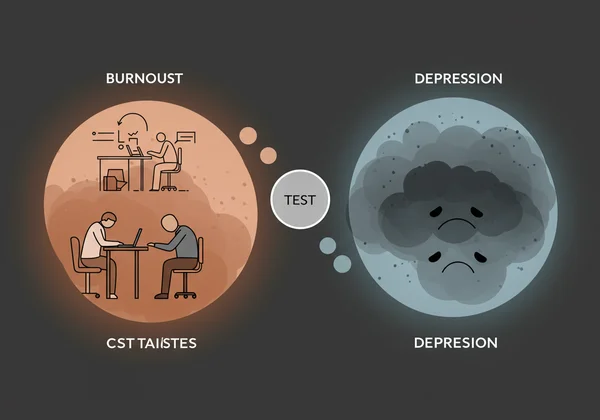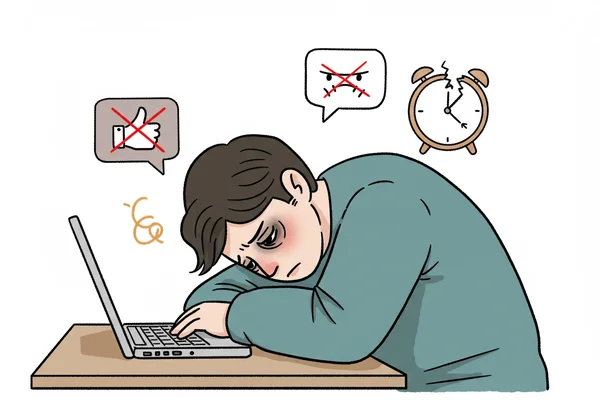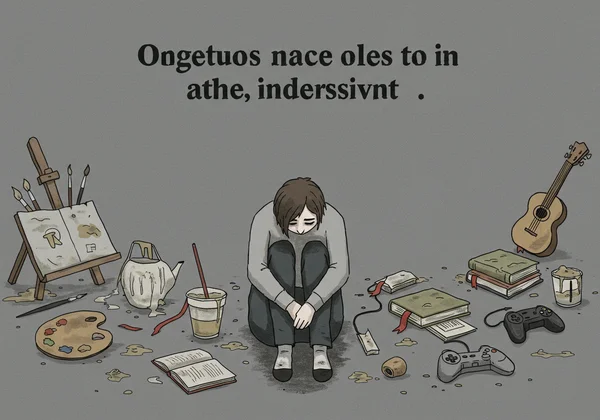Burnout vs. Depresi: Fahami Perbezaan dengan Ujian Depresi
Merasa letih secara kronik, sinis, dan kurang berkesan, tetapi tidak pasti mengapa? Anda tidak bersendirian. Dalam dunia serba pantas kita, garisan antara tekanan berkaitan kerja yang kuat dan gangguan mood yang lebih meluas boleh terasa kabur. Ramai orang keliru gejala burnout dengan kemurungan klinikal, dan kekeliruan ini boleh melambatkan penerimaan bantuan yang betul. Panduan komprehensif ini akan membantu anda memahami ciri-ciri berbeza antara burnout vs. kemurungan, membolehkan anda untuk mengenal pasti apa yang mungkin anda alami. Ramai bertanya, "Bagaimanakah saya boleh menyemak sama ada saya mengalami kemurungan?" Memahami perbezaan antara kedua-dua keadaan ini adalah langkah kritikal pertama ke arah memulihkan kesejahteraan mental anda, dan ujian kemurungan dalam talian awal boleh menawarkan kejelasan yang berharga.

Memahami Burnout: Apabila Tekanan Kronik Memberi Kesan
Burnout (keletihan kerja) ialah keadaan keletihan emosi, fizikal, dan mental yang disebabkan oleh tekanan yang berlebihan dan berpanjangan. Ia diiktiraf secara rasmi oleh Pertubuhan Kesihatan Sedunia (WHO) sebagai "fenomena berkaitan pekerjaan," yang bermaksud ia secara khusus dikaitkan dengan persekitaran kerja anda. Ia bukanlah keadaan perubatan itu sendiri, tetapi sebaliknya merupakan tindak balas kepada tekanan kerja kronik yang tidak berjaya diuruskan. Fikirkannya sebagai isyarat minda dan badan anda bahawa anda telah kehabisan tenaga terlalu lama.
Apakah Burnout Pekerjaan? Mendefinisikan Keadaan
Pada asasnya, burnout berlaku akibat ketidakpadanan yang mendalam antara anda dan pekerjaan anda. Ini boleh disebabkan oleh beban kerja yang terlalu banyak, kekurangan kawalan atau autonomi, kerja yang tidak memuaskan, persekitaran sosial yang toksik, atau pertembungan antara nilai anda dan syarikat. Ia perlahan-lahan mengikis tenaga dan motivasi anda, membuatkan anda berasa letih dan terputus hubungan daripada sebahagian kehidupan yang pernah mungkin membawa kepuasan kepada anda. Ia adalah tindak balas situasional kepada persekitaran yang telah menjadi tidak mampan untuk kesihatan mental anda.
Penunjuk Utama: Keletihan, Sinisme, dan Pengurangan Keberkesanan Profesional
Burnout biasanya bermanifestasi melalui tiga dimensi teras:
- Keletihan: Ini melangkaui rasa penat biasa. Ia adalah rasa mendalam bahawa tiada apa lagi yang boleh diberikan. Anda mungkin berasa letih secara fizikal dan emosi, bergelut untuk bangun dari katil pada waktu pagi, dan mendapati bahawa rehat pun nampaknya tidak dapat memulihkan tenaga anda.
- Sinisme dan Keterasingan: Anda mungkin mula berasa semakin negatif dan sinis tentang pekerjaan anda. Ini boleh membawa kepada menjauhkan diri secara mental daripada kerja dan rakan sekerja anda. Semangat atau penglibatan yang pernah anda miliki digantikan oleh perasaan kecewa, mudah marah, dan keinginan untuk mengasingkan diri.
- Pengurangan Keberkesanan Profesional: Ini melibatkan rasa tidak kompeten yang semakin meningkat dan kekurangan pencapaian di tempat kerja. Walaupun bekerja lebih keras, anda mungkin merasa bahawa sumbangan anda tidak penting atau anda gagal dalam tugas anda. Ini boleh mengikis keyakinan anda dan mewujudkan kitaran tekanan dan prestasi rendah yang ganas.

Membongkar Kemurungan: Lebih Daripada Sekadar Merasa Sedih
Walaupun burnout adalah tindak balas kepada persekitaran tertentu (pekerjaan), kemurungan adalah gangguan mood klinikal yang mempengaruhi cara anda merasa, berfikir, dan mengendalikan aktiviti harian. Ia dicirikan oleh perasaan sedih yang berterusan atau kehilangan minat terhadap perkara yang pernah anda nikmati. Tidak seperti burnout, perasaan yang dikaitkan dengan kemurungan adalah menyeluruh, mewarnai setiap aspek kehidupan anda, bukan hanya waktu bekerja anda.
Apakah Gangguan Kemurungan Utama (Kemurungan Klinikal)?
Gangguan Kemurungan Utama (MDD) adalah keadaan perubatan yang serius yang berpunca daripada gabungan faktor genetik, biologi, persekitaran, dan psikologi. Ia bukan sekadar "rasa muram" atau kelemahan yang boleh anda "sembuhkan" begitu sahaja. Ia menyebabkan perubahan ketara dalam kimia dan fungsi otak, yang membawa kepada gejala berterusan yang boleh mengganggu keupayaan anda untuk bekerja, tidur, belajar, makan, dan menikmati kehidupan. Mengiktirafnya sebagai keadaan kesihatan yang sah adalah penting untuk rawatan yang berkesan.
Gejala Biasa: Perubahan Mood, Fizikal, dan Kognitif
Tanda amaran kemurungan adalah luas dan boleh menjejaskan anda dalam pelbagai cara. Walaupun diagnosis profesional diperlukan, gejala biasa termasuk:
-
Mood Rendah yang Menyeluruh: Perasaan sedih, kosong, atau putus asa yang berterusan yang hadir hampir sepanjang hari, hampir setiap hari.
-
Kehilangan Minat atau Kesenangan (Anhedonia): Ketidakminatan yang ketara dalam hobi, aktiviti, atau perjumpaan sosial yang pernah anda nikmati sebelum ini.
-
Perubahan Ketara dalam Berat Badan atau Selera Makan: Ini boleh bermanifestasi sama ada kehilangan berat badan yang ketara tanpa diet atau penambahan berat badan daripada peningkatan keinginan.
-
Gangguan Tidur: Insomnia (kesukaran tidur) atau hipersomnia (tidur terlalu banyak) adalah perkara biasa.
-
Kegelisahan Fizikal atau Perlambatan: Merasa gelisah dan penuh keresahan atau, sebaliknya, merasa pergerakan dan pemikiran anda perlahan.
-
Kelesuan atau Kehilangan Tenaga: Kelesuan yang mendalam yang tidak dapat diatasi dengan tidur, menjadikan tugas-tugas kecil terasa besar.
-
Perasaan Tidak Berharga atau Rasa Bersalah yang Berlebihan: Kritikan diri yang kasar atau terfokus pada kegagalan masa lalu.
-
Kesukaran Menumpukan Perhatian atau Membuat Keputusan: Fungsi kognitif boleh terjejas, membawa kepada ketidakupayaan membuat keputusan dan masalah ingatan.

Burnout vs. Kemurungan: Membongkar Perbezaan Kritikal
Walaupun terdapat banyak simptom yang bertindih, terutamanya dengan keletihan dan mood rendah, perbezaan teras antara burnout dan kemurungan adalah penting untuk menentukan tindakan yang betul.
Punca Asal: Situasional vs. Faktor Biokimia & Lebih Luas
Perbezaan yang paling ketara terletak pada asal usulnya. Burnout hampir selalu dikaitkan secara langsung dengan pekerjaan anda atau peranan stres tertentu (seperti penjagaan). Tekanan adalah luaran dan situasional. Jika anda mengambil cuti panjang atau menukar pekerjaan, gejala burnout selalunya bertambah baik dengan ketara.
Sebaliknya, kemurungan adalah lebih global. Walaupun pekerjaan yang tertekan pastinya boleh mencetuskan atau memburukkan episod kemurungan, keadaan itu adalah dalaman dan menyeluruh. Perasaan negatif, putus asa, dan kehilangan minat meluas ke semua aspek kehidupan anda—keluarga, persahabatan, dan hobi. Cuti mungkin menawarkan sedikit kelegaan sementara, tetapi perasaan asas biasanya kembali kerana punca asal bukan hanya persekitaran. Jika anda mengesyaki perasaan anda adalah begitu meluas, ia mungkin berguna untuk menilai gejala anda.
Lanskap Emosi: Sinisme vs. Mood Rendah yang Menyeluruh
Lanskap emosi kedua-dua keadaan juga berbeza. Dalam burnout, emosi utama selalunya adalah kekecewaan, sinisme, dan mudah marah yang berkaitan dengan pekerjaan. Anda mungkin berasa marah atau kesal tentang pekerjaan anda.
Dalam kemurungan, lanskap emosi didominasi oleh mood rendah yang menyeluruh, perasaan tidak berharga, rasa bersalah, dan putus asa yang tidak terikat pada satu punca. Ia kurang tentang kemarahan terhadap situasi dan lebih kepada kesedihan mendalam dan pandangan negatif terhadap diri sendiri dan dunia.
Kesan Terhadap Identiti dan Fungsi Harian
Burnout menyerang identiti profesional anda. Ia membuatkan anda berasa tidak berkesan dan kecewa dengan kerjaya anda. Anda mungkin masih dapat mencari kegembiraan dalam hobi hujung minggu atau makan malam keluarga.
Walau bagaimanapun, kemurungan menyerang teras diri anda. Ia boleh membuatkan anda berasa tidak berharga sebagai seorang individu, bukan hanya sebagai pekerja. Perbezaan asas ini adalah sebab mengapa kemurungan merampas keseronokan anda dalam semua aktiviti, bukan hanya yang berkaitan dengan pekerjaan. Jika ini kedengaran biasa, mengambil penilaian kemurungan sulit boleh menjadi langkah seterusnya yang membantu.

Apa yang Perlu Dilakukan Seterusnya: Daripada Kesedaran Diri kepada Tindakan
Mengenali tanda-tanda adalah langkah pertama. Seterusnya ialah mengambil tindakan bersasar berdasarkan apa yang anda percaya anda alami.
Strategi untuk Pemulihan dan Pencegahan Burnout
Jika gejala anda terutamanya berkaitan dengan kerja, fokus haruslah pada mengubah hubungan anda dengan pekerjaan anda:
- Tetapkan Batasan Tegas: Tentukan dengan jelas waktu kerja anda dan patuhiinya. Elakkan memeriksa e-mel selepas waktu kerja.
- Ambil Cuti yang Bermakna: Gunakan masa cuti anda. Ambil cuti pendek sepanjang hari untuk terputus dan memulihkan tenaga.
- Menilai Semula Peranan Anda: Berbincang dengan pengurus anda tentang beban kerja atau tanggungjawab anda. Lihat sama ada terdapat cara untuk mendelegasikan tugas atau mengalihkan fokus anda kepada projek yang lebih menarik.
- Utamakan Penjagaan Diri: Laburkan masa dalam hobi, senaman, dan perhubungan sosial di luar kerja untuk membina semula tenaga dan rasa diri anda.
Mempertimbangkan Ujian Kemurungan: Bilakah Perlu Mencari Wawasan Lebih Dalam
Jika gejala anda terasa lebih menyeluruh—mempengaruhi mood dan minat anda di luar kerja, menjejaskan tidur dan selera makan anda, dan disertai dengan perasaan putus asa—ia mungkin lebih daripada burnout. Di sinilah penilaian awal boleh menjadi sangat berguna. Skor ujian kemurungan dalam talian bukanlah diagnosis, tetapi ia berfungsi sebagai alat yang berharga dan sulit untuk membantu anda menyusun pemikiran anda dan menilai keadaan emosi anda. Ia boleh memberikan ringkasan berstruktur tentang gejala anda, menjadikannya lebih mudah untuk berbual dengan profesional penjagaan kesihatan.
Kepentingan Diagnosis dan Sokongan Profesional
Sama ada anda mengesyaki burnout atau kemurungan, berbincang dengan seorang profesional adalah langkah yang paling penting. Doktor atau ahli terapi kesihatan mental boleh memberikan diagnosis yang tepat dan mencipta pelan rawatan yang disesuaikan. Untuk burnout, ini mungkin melibatkan teknik pengurusan tekanan atau kaunseling kerjaya. Untuk kemurungan, rawatan mungkin termasuk terapi (seperti CBT), ubat-ubatan, atau penyesuaian gaya hidup. Jangan teragak-agak untuk mendapatkan bantuan—ia adalah tanda kekuatan.
Langkah Seterusnya Ke Arah Kesejahteraan Anda
Mengenali sama ada anda mengalami burnout atau kemurungan adalah langkah pertama yang berkuasa ke arah penyembuhan dan memulihkan kesihatan mental anda. Burnout adalah tanda bahawa persekitaran kerja anda perlu diubah, manakala kemurungan adalah isyarat bahawa kesejahteraan keseluruhan anda memerlukan perhatian dan penjagaan.
Walaupun kedua-duanya memerlukan tindakan, memahami perbezaan mereka membolehkan strategi yang disasarkan untuk pemulihan. Jika, selepas menyemak perbezaan ini, anda mengesyaki gejala anda lebih sejajar dengan kemurungan, mengambil penilaian dalam talian awal yang sulit boleh memberikan wawasan yang berharga. Lawati laman web kami untuk mengambil ujian kemurungan percuma dan lebih memahami perasaan anda. Ia adalah cara yang sepenuhnya peribadi untuk lebih memahami perasaan anda dan boleh menjadi titik permulaan untuk perbualan yang produktif dengan profesional penjagaan kesihatan. Ingat, anda tidak perlu mengharungi ini sendirian.
Soalan Lazim Mengenai Burnout & Kemurungan
Bagaimanakah saya boleh menyemak sama ada saya mengalami kemurungan?
Pemeriksaan yang pasti memerlukan diagnosis daripada profesional penjagaan kesihatan yang berkelayakan. Walau bagaimanapun, langkah pertama yang hebat ialah menggunakan alat saringan dalam talian yang sulit. Sumber seperti ujian kemurungan percuma boleh membantu anda menilai gejala anda berdasarkan kriteria biasa untuk kemurungan, memberikan gambaran keseluruhan berstruktur yang kemudiannya boleh anda bincangkan dengan doktor.
Adakah saya mengalami kemurungan atau sekadar sedih?
Kesedihan adalah emosi manusia biasa yang biasanya bersifat sementara dan dikaitkan dengan peristiwa tertentu. Sebaliknya, kemurungan adalah keadaan mood rendah, putus asa, dan kehilangan minat yang berterusan yang berlangsung sekurang-kurangnya dua minggu dan secara ketara menjejaskan keupayaan anda untuk berfungsi dalam kehidupan seharian.
Apakah tanda-tanda amaran kemurungan?
Tanda amaran utama termasuk mood sedih atau kosong yang berterusan, kehilangan minat terhadap aktiviti yang pernah anda nikmati, perubahan ketara dalam tidur atau selera makan, kelesuan yang mendalam, kesukaran menumpukan perhatian, perasaan tidak berharga atau rasa bersalah, dan dalam kes yang teruk, fikiran untuk mencederakan diri sendiri.
Bagaimanakah ujian kemurungan boleh membantu saya memahami gejala saya?
Ujian kemurungan dalam talian bertanya soalan standard berdasarkan alat saringan profesional seperti PHQ-9. Ia membantu anda mengkaji perasaan dan tingkah laku anda secara objektif dalam tempoh baru-baru ini. Keputusan memberikan skor awal dan ringkasan yang boleh mengesahkan kebimbangan anda, membantu anda meluahkan perasaan anda, dan memberi anda keyakinan untuk mendapatkan bantuan profesional.